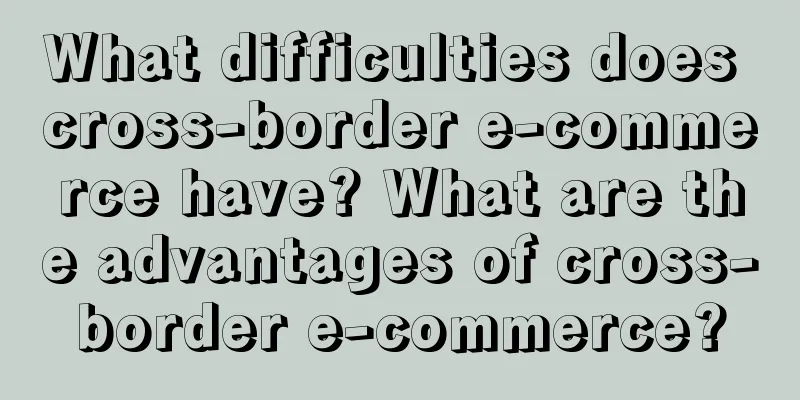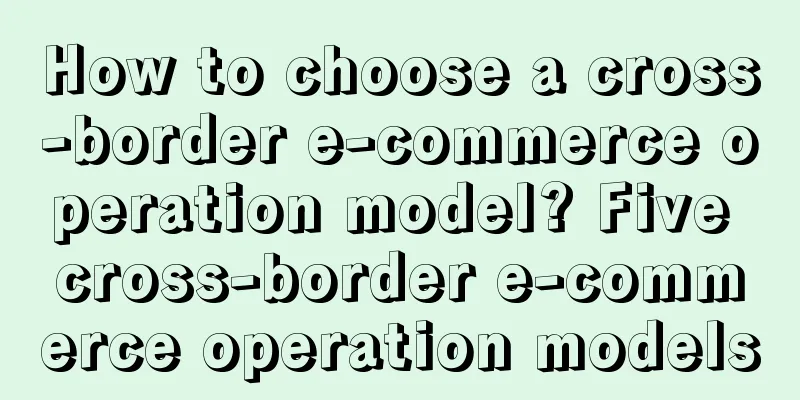What difficulties does cross-border e-commerce have? What are the advantages of cross-border e-commerce?

|
With the advancement of globalization and the rapid development of Internet technology, cross-border e-commerce has become a booming industry. However, compared with domestic e-commerce, cross-border e-commerce faces a series of unique difficulties. This article will analyze these problems from different angles and explore how to deal with and overcome them. 1. What are the difficulties of cross-border e-commerce? International logistics and transportation: Cross-border e-commerce needs to face a complex international logistics and transportation system. Including customs clearance, bonded area operation, cargo transportation and other links, all need to deal with different laws and regulations, tax policies and transportation methods of different countries. In addition, product packaging and distribution also need to consider the cultural customs and consumer needs of different countries and regions. Cross-border payments and financial risks: Due to the involvement of currencies and payment systems in different countries and regions, cross-border e-commerce faces payment settlement and financial risks. Issues such as payment systems in different countries, exchange rate fluctuations, and credit card fraud can increase transaction uncertainty and risks. Language and cultural differences: Language and cultural differences are also an important issue when conducting cross-border e-commerce. Different countries and regions have different languages and cultural customs, which may affect the promotion and sales of products. At the same time, customer service also needs to consider multilingual communication and comply with local laws and regulations. Intellectual property protection: Cross-border e-commerce involves the protection and enforcement of intellectual property rights. In some countries, the intellectual property protection system may be relatively weak, and the risk of piracy and counterfeiting of goods is relatively high. Therefore, protecting their own brands and intellectual property rights has become an important task for cross-border e-commerce companies. 2. What are the advantages of cross-border e-commerce? Although cross-border e-commerce faces some difficult issues, it also has many unique advantages. Market expansion and globalization opportunities: Through cross-border e-commerce, companies can expand their markets to the global level. Whether importing or exporting, they can gain a wider consumer base and sales opportunities. In addition, cross-border e-commerce can help companies realize their globalization strategies and strengthen international cooperation and exchanges. Supply chain optimization: Cross-border e-commerce can optimize the supply chain and reduce inventory and capital costs. By cooperating with foreign suppliers, you can get better purchase prices and more choices. At the same time, using Internet technology and data analysis, you can achieve visualization and intelligent management of the supply chain. Product features and differentiation: Cross-border e-commerce can provide enterprises with more product features and differentiation opportunities. By understanding the market demands of different countries and regions, products with unique features can be developed and promoted. At the same time, cross-border e-commerce can also help enterprises to innovate and cooperate with overseas suppliers to promote product upgrades and improvements. Cost and efficiency advantages: Compared with traditional trade models, cross-border e-commerce has lower operating costs and higher efficiency. Through online platforms and digital technologies, order processing, inventory management, and logistics distribution can be automated and intelligent. At the same time, cross-border e-commerce can also reduce intermediate links and channels, reduce costs and prices, and improve the competitiveness of enterprises. In summary, although cross-border e-commerce faces a series of difficulties, it also brings many unique advantages. By fully understanding and coping with these difficulties, companies can effectively take advantage of cross-border e-commerce opportunities to expand markets, optimize supply chains, innovate products, and improve cost-effectiveness. In the context of globalization, cross-border e-commerce has become a development trend that cannot be ignored. For companies, seizing this opportunity means broader development space and a larger market share. Recommended reading: How to ship goods through cross-border e-commerce? What are the methods? Is Shopee, a cross-border e-commerce platform in Southeast Asia, reliable? What are its advantages? What attributes should be considered when selecting products for cross-border e-commerce? What are the tips for selecting products? |
>>: What are the management advantages of a cross-border e-commerce manager? How to do it well?
Recommend
Why did Shopee not receive any orders for a month? What are the reasons?
Every merchant who opens a store online hopes that...
How much inventory should Amazon stock? How does Amazon operate?
Speaking of stockpiling, many merchants are actual...
Where is the entrance to eBay's US official website? How to avoid buying fakes?
Now many friends will do cross-border e-commerce p...
Is the Allegro cross-border e-commerce platform real or fake? How do cross-border e-commerce platforms combat counterfeit goods?
When choosing the right platform, consumers often ...
What should I do if Shopee is unable to ship the goods in time? What will happen if the goods are shipped overdue?
For e-commerce, product selection, title, detail p...
What types of Amazon invoices are there? How to issue an invoice?
As an important basis for shopping receipts and fi...
The ticket is 40 yuan and the surrounding area is 800 yuan. Hongshan Zoo is really good.
Nanjing Hongshan Forest Zoo has become popular on ...
What to do if Amazon restricts replenishment? How to avoid replenishment restrictions?
When opening a store on Amazon, replenishment is a...
10,000-word analysis | How to achieve global conversion through people-oriented marketing on Xiaohongshu
How can brands conduct people-oriented marketing o...
Do digital credit cards have physical cards? Where can I apply for a digital credit card?
With the rapid development of financial technology...
Content IP, another path besides traffic business
This article explores the commercial potential of ...
Generation Z loves trendy things! (Part 1)
From philately to cultural relics, people's lo...
After Taobao free orders, netizens catch up on cultural studies
This article uses the interesting case of Taobao&#...
Will the video notes watched by millions of fans bring new traffic dividends to Xiaohongshu?
In today's era of social media, video content ...
Long article review: 5 tips for successful incentive systems in 18 Internet benchmark products
How to keep users in the product as much as possib...









